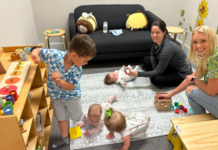Many of you are probably familiar with Autism Awareness Month/Day, which occurs each April as a way to educate the public about Autism. While most people are aware Autism exists, the depiction of it as a problem that needs to be solved negatively impacts the quality of life for autistic children and adults. Autism Acceptance Month/Day was created by autistic adults to change the narrative around Autism. They use their experiences to bring a new understanding of what autism is and what it means to be autistic.
Last April was my first time celebrating Autism Acceptance Month and Autism Acceptance Day (April 2). As a parent of an autistic child and a NeuroLurker myself, I have spent years sifting through the doom and gloom associated with being autistic, in order to gain a clearer picture of how I can be a better advocate for my son and help him live a happier, healthier life. What I found was organizations, blogs, and social media pages/groups created by autistic adults to educate on, and de-stigmatize, Autism.
Unfortunately, decades of outdated and disproven research, along with negative portrayals of autistic people, empower some non-autistics (which sadly includes doctors, therapists, and even parents of autistic children) to ignore and speak over those with Autism. Where Autism Acceptance Month should be a celebration, there are still a lot of misconceptions and biases to overcome. With this in mind, here are three ways you can show your support for Autism acceptance this April.
 1. Support Autistic Advocacy Organizations, Blogs, and Social Media
1. Support Autistic Advocacy Organizations, Blogs, and Social Media
There are many Autism organizations, but not all of them actually benefit autistic individuals and their families. Some use stigmatizing language, promote cures and abuse in the form of therapy, or lack autistic representation in their leadership. So, it’s important to find proper organizations that support autistic individuals in a beneficial way.
These are just a few of the growing number of autistic created and led advocacy organizations, blogs, and social media pages to consider supporting:
- Autastic
- Autistic Women & Nonbinary Network (AWN)
- CommunicationFIRST
- Neuroclastic
- Therapist Neurodiversity Collective
2. Switch Up Your Colors
The blue or rainbow puzzle pieces are the most recognized symbols of Autism. Families of autistic children and adults use them to show their personal connection to Autism and their support for Autism awareness. However, the majority (not all) of autistic individuals find the puzzle piece to be offensive because it purports the fallacy that Autism is a childhood disorder, a problem to be solved, or that there is a missing piece within autistic people.
So if blue puzzle pieces are out, what is in?
Red has been adopted by many autistic advocates and their allies to protest certain Autism organizations that perpetuate misconceptions about Autism and dangerous treatments for autistic people. Taupe and gold are other colors used to represent autistic acceptance. The gold infinity symbol is used to represent autistic acceptance, along with the rainbow infinity symbol for neurodiversity.
3. Hashtag It Out
One of my Facebook friends is autistic and a mother of autistic children. She shares a lot of posts about Autism and speaks about her own experiences. It’s through the hashtags on those posts that I was able to learn more about Autism and advocacy. Along with clicking on them to peruse the results, I recommend using them in your own posts to keep the flow of information going.
These are the hashtags that I found to be the most useful during Autism Acceptance Month and all year long:
- #RedInstead
- #LightItUpGold
- #ToneItDownTope
- #AskAnAutistic/#AskingAutistics
- #ActuallyAutistic (Shouldn’t be used in posts unless you are autistic. Its most important use is to help autistics to find online community.)
This is neither an extensive nor definitive list of how to support and celebrate Autism acceptance. I just hope that the biggest takeaway is that Autism acceptance begins with listening to, and learning from, the people who experience being autistic firsthand. This includes those who are non-verbal, those who have physical or learning disabilities, autistic BIPOC, and autistic LGBTQ.
Let’s work together to create a better present and a brighter future for autistic children.














